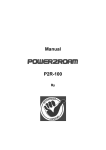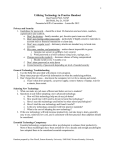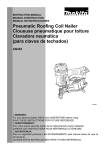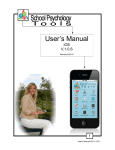Download Toshiba GR-H41TA Refrigerator User Manual
Transcript
REFRIGERATOR-FREEZER OPERATING INSTRUCTIONS MODEL GR-H41TA GR-H46TA • Thank you very much for selecting the Toshiba Refrigerator. Read this pamphlet of instructions for the correct and effective use of your Toshiba Refrigerator. N13677 Approval No.Q051002 SAFETY IMPORTANT MESSAGES Read this manual and follow its instructions. Signal words such as WARNING, CAUTION will be followed by important safety information that must be carefully reviewed. WARNING Indicate a potentially hazardous situation which could result in death or serious injury if you do not follow instructions. CAUTION Indicate a situation which, if not avoided, may result in minor injury or property damage. WARNING L GR-H41TA, GR-H46TA • Get a 230-240V power supply by putting the plug in a wall socket properly wired. • Use a special outlet for the refrigerator. Plugging several appliances into one outlet will cause the outlet to heat and may result in a fire. • Highly inflammable spray lacquer or paint must not be stored in the refrigerator or placed or used nearby. These could be ignited by sparks produced as the switch of the refrigerator is turned on or off. • Alcohol, benzene, paint thinner, etc. should not be stored in the refrigerator as they could explode. • Do not place vessels filled with water, etc. on the refrigerator. The liquid spilt will lower electric insulation performance and may cause fire or electrical shock. Or, if dropped, it may cause injury. • Do not spilt water directly on the refrigerator. Water on the electrical lines and parts could result in a short or other malfunction. • Do not hang down from the door. If so, the refrigerator may fall down and this may cause injury, or the fingers may be caught in the door. • If the supply cord of this appliance is damaged, it must only be replaced by a repair shop appointed by manufacturer, in order to avoid a hazard. • Do not place weight on the supply cord. Make sure that the cord is free of the casters of the refrigerator, and that no furniture or other objects are placed on the cord. Heavy weight placed on the cord may damage it and lead to scorching or short circuit. • The appliance is not intended for use by young children or infirm persons without supervision. • Young children should be supervised to ensure that they do not play with the appliance. 2 • When disposing the refrigerator; • Do not leave in places where children play. • To protect a little children from dangerous confinement inside the refrigerator, remove the door packing so that the door can not be closed air-tightly. • Should be followed the disposal law of your country. • • Keep ventilation openings, in the appliance enclosure or in the built-in structure, clear of obstruction. • • Do not damage the refrigerant circuit. Do not use mechanical devices or other means to accelerate the defrosting process, other than those recommended by the manufacturer. Do not use electrical appliances inside the food storage compartments of the appliance, unless they are of the type recommended by the manufacturer. CAUTION • Do not touch food or metal containers inside the freezer with wet hands. Because of the low temperature, your hands may freeze with the item you touched. • When the refrigerator is carried, it must be held at the positions shown in the diagram on page 5. (Do not hold the door or the handle.) INSTALLATION When you open the door of the refrigerator, there may be some smell of plastics. This signifies nothing unusual. ○ ○ ○ ○ ○ ○ ○ ○ ○ ○ ○ ○ ○ ○ ○ ○ ○ ○ ○ ○ ○ ○ ○ ○ ○ ○ ○ ○ ○ ○ ○ ○ ○ ○ ○ ○ ○ ○ ○ ○ ○ ○ ○ ○ ○ ○ ○ ○ ○ ○ ○ ○ ○ ○ ○ ○ ○ ○ ○ ○ ○ ○ ○ ○ ○ ○ ○ ○ ○ ○ ○ Select a dry place. Avoid any humid or wet place, for example, the neighborhood of a kitchen sink. Such a place could cause corrosion or electric leakage in the refrigerator. If installed directly on the ground, your refrigerator will be liable to damage. Place a board under the machine in such a case. ○ ○ ○ ○ ○ ○ ○ ○ ○ ○ ○ ○ ○ ○ ○ ○ ○ ○ ○ ○ ○ ○ ○ ○ ○ ○ ○ ○ ○ ○ ○ ○ ○ ○ ○ ○ ○ ○ ○ ○ ○ ○ ○ ○ ○ ○ ○ ○ ○ ○ ○ ○ ○ ○ ○ ○ ○ ○ ○ ○ ○ ○ Installation. Install your Toshiba Refrigerator on a strong and level floor. Turn the leveling screws and stabilize the refrigerator horizontally. ○ ○ ○ ○ ○ ○ ○ ○ ○ ○ ○ ○ ○ ○ ○ ○ ○ ○ ○ ○ ○ ○ ○ ○ ○ ○ ○ ○ ○ ○ ○ ○ ○ ○ ○ ○ ○ ○ ○ ○ ○ ○ ○ ○ ○ ○ ○ ○ ○ ○ ○ ○ ○ ○ ○ ○ ○ ○ Leave space around the refrigerator. Select a well-ventilated place. Provide at least 10 cm (4 inches) at top and 4 cm (1.6 inches) on both sides for proper air circulation. ○ ○ ○ ○ at least 10 cm at least 4 cm ○ ○ ○ ○ ○ ○ ○ ○ ○ ○ ○ ○ ○ ○ ○ ○ ○ ○ ○ ○ ○ ○ ○ ○ ○ ○ ○ ○ ○ ○ ○ ○ ○ ○ ○ ○ ○ ○ ○ ○ ○ ○ ○ ○ ○ ○ ○ ○ ○ ○ ○ ○ ○ ○ ○ ○ ○ ○ ○ ○ ○ ○ ○ ○ ○ ○ ○ ○ ○ ○ ○ ○ ○ ○ ○ ○ ○ ○ ○ ○ ○ ○ ○ ○ ○ ○ ○ ○ ○ ○ ○ ○ ○ ○ ○ ○ ○ ○ ○ ○ ○ ○ ○ ○ ○ ○ ○ ○ ○ ○ ○ ○ ○ ○ ○ ○ ○ ○ Use in a cool place. ○ ○ ○ ○ ○ ○ ○ ○ ○ ○ ○ ○ Keep the refrigerator away from direct sunlight, a gas or heated sources. If the refrigerator is installed in direct sunlight or near a heat emitted object, this will deteriorate the cooling system and it may malfunction. 3 IDENTIFICATION AND FUNCTIONS OF PARTS Ice Twist Ice Box Freezer Door Pocket Freezer Shelf Control Panel (Refrigerator Compartment) Meat Case Control Panel (Freezing Compartment) Egg Pocket Interior Lamp Plasma Deodorizer Mini Pocket Lower Shelf Crisper Shelf Vegetable Crisper Bottle Pocket Leveling Screws TYPE MODEL CONSUMPTION GR-H41TA Ice Twist Ice Box Mini Pocket Lower Shelf = = = = 2 Pcs 1 Pcs 1 Pcs 2 Pcs GR-H46TA Ice Twist Ice Box Mini Pocket Lower Shelf = = = = 2 Pcs 1 Pcs 2 Pcs 3 Pcs A B HOW TO USE YOUR REFRIGERATOR CORRECTLY AND EFFECTIVELY Temperature Control Dial Freezing Compartment Temperature Dial Refrigerator Compartment Temperature 5 When set to “5”, the temperature will be 2 to 3 degrees lower than “3”. 5 When set to “5”, the temperature will be 1 to 2 degrees lower than “3”. 3 Approx–19°C 3 Approx 4°C 1 When set to “1”, the temperature will be 3 to 4 degrees higher than “3”. 1 When set to “1”, the temperature will be 3 to 4 degrees higher than “3”. When storing ice cream, the temperature should be set below “3”. • • If the refrigerator does not seem cold enough, turn the dials toward “5”, if it seems too cold, turn the dials toward “1”. The above temperatures are the temperatures at the center of the freezer and refrigerator compartment respectively. The temperature measurements were made with a surrounding temperature of 30°C, with no food inside the refrigerator, the door closed, and after the temperature had stabilized. How to Make Ice 1 Fill the ice tray with water up to the water level line. If the water exceeds the water level line, if freezes over and becomes hard to remove. 2 Water level line 4 To remove ice, twist the ice twist as shown in the figure. INFORMATION • Heat Generation by the Compressor The refrigerator compressor will generate heat during normal operation. Note that this is not a malfunction. • Heat on Refrigerator Walls The condenser is built the outer shell and radiates heat into the room air. The temperature of the outer shell may reach high temperature during normal refrigerator operation. This is not a malfunction. Don’t panic! This refrigerator will ventilate the heat through the wall of both left and right sides. And the hot tube will distribute to the front edge of the refrigerator to keep out the humidity and prevent condensing. This will also prolong the use of the refrigerator. • Refrigerator Operation When the power is first turned on or when the power comes on again after an extended power outage, the refrigerator may run continuously for 9 to 14 hours in order to cool the entire cabinet to the normal operating temperature. When the inside temperature has stabilized, the refrigerator will enter the automatic control mode. Should the refrigerator run continuously under the above conditions, remember that this is not a malfunction. CAUTIONS FOR OPERATION The refrigerator should not be used to store chemical materials or medical products. ○ ○ ○ ○ ○ ○ ○ ○ ○ ○ ○ ○ ○ ○ ○ ○ ○ ○ ○ ○ ○ ○ ○ ○ ○ ○ ○ ○ ○ ○ ○ ○ ○ ○ ○ ○ ○ ○ ○ ○ ○ ○ ○ ○ ○ ○ ○ ○ ○ ○ ○ ○ ○ ○ ○ ○ ○ ○ ○ ○ ○ ○ ○ ○ ○ ○ ○ ○ ○ ○ ○ After removing the plug from the outlet, wait at least 7 minutes before reinserting it. • If the plug is reinserted too soon, the compressor may not run properly and may produce a rattling noise. ○ ○ ○ ○ ○ ○ ○ ○ ○ ○ ○ ○ ○ ○ ○ ○ ○ ○ ○ ○ ○ ○ ○ ○ ○ ○ ○ ○ ○ ○ ○ ○ ○ ○ ○ ○ ○ ○ ○ ○ ○ ○ ○ When Moving and Transporting • First remove the food. • When carrying, hold the positions shown in the diagram. (Never hold by the door or handle.) Rear upper side Front lower side When Transporting while relocating • Do not lay the refrigerator on its side. Doing so may cause it to malfunction. 5 ○ ○ ○ ○ ○ ○ ○ ○ ○ ○ ○ ○ ○ ○ ○ ○ HOW TO REMOVE ACCESSORY PARTS The accessory parts can be easily removed as explained below for easier cleaning. Only the removal steps are explained here. Replace each part in reverse order. Egg Pocket Freezer Shelf Pull out the shelf until it stops while lifting it slightly and then pull out down-ward. • • Removal Lift up in the direction shown by the arrow. Meat Case Pull out it by lifting its depth side. Mounting Insert the left side first and then lower the right side. Mini Pocket, Bottle Pocket 1 2 Lightly press upward at right hand side and remove. Lift up the left hand side while pulling the right hand side toward you. Lower Shelf, Crisper Shelf Pull out the shelf until it stops while lifting it slightly then pull out down-ward. In case of the crisper shelf, remove the vegetable crisper first. Vegetable Crisper • Rotate as shown in the direction shown by the arrows. How to Replace Lamp 1. Remove A.C. Plug 2. Use screwdriver pushing up left or right of shade 3. Pull shade this side 4. Take off Lamp _ WARNING Remove A.C. Plug before Replacing Lamp Use: 15 Watt lamp Front Lower Cover Remove the front lower cover by pulling it diagonally upward and clean with water. When installing, insert if from the front side. PERIODIC MAINTENANCE To ensure the maximum life of your Toshiba Refrigerator, periodically clean its parts. (For proper instructions, read the following directions carefully.) When cleaning them, be sure to pull out the refrigerator’s plug from the socket and be careful not to pull the cord or get it caught under the machine. Do not pour water directly on the refrigerator. Outside Surfaces Polish them with a soft rag. A heavy stain should be wiped off with a rag soaked in a cleanser solution. The door handle should be wiped with a dry cloth. 6 Door Packing The packing on the doors will be short-lived if stains are not removed. Occasionally, inspect the packing on the doors, and remove any stain with a cleanser solution. Interior Plastic units If they are stained or have any odor, the interior plastic units should be cleaned with a cleanser solution. When smeared with salad oil or other cooking oil, the interior plastic unit may crack. Wipe such smears off. BEFORE REQUESTING REPAIR If you think the refrigerator is not functioning properly, please check the following points, and then consult representatives of the store where you purchased it. The refrigerator does not get cold at all. • Is the refrigerator plugged in properly ? • Has the fuse for your house’s electricity supply blown, or has the breaker shut off ? • Has the electricity supply been shut off ? The refrigerator does not get cold enough. • Is the temperature control dial set to “1” ? • Is the refrigerator placed in direct sunlight, or near a stove or heater ? • Is the door closed properly ? • Is the door being opened and closed too frequently ? Has anything hot been placed in the refrigerator ? • Is the refrigerator overloaded ? • Is there sufficient air circulation around the refrigerator ? Food in the refrigerator compartment freezes. • Is the temperature control dial set to “5” ? • Is the surrounding temperature below 5°C ? • Have you placed food with a high moisture content at the rear of the compartment, hence making it prone to freezing ? The refrigerator is noisy. • Is the floor firm and level ? • Have any trays or dishes been left around the refrigerator ? • Is the refrigerator unstable, or touching the wall ? Moisture forms on the outside of the refrigerator. • Sometimes moisture may form on the outside of the refrigerator, particularly when humidity is high, such as during the rainy season. This is just the same as moisture forming on a glass which contains cold water, and is not indicative of a malfunction. If moisture forms on the refrigerator, just wipe it off with a dry cloth. Moisture forms on the inside of the refrigerator. • Is the door being opened and closed too frequently, or left open for long periods of time ? • Has food with a high moisture content been left uncovered in the refrigerator ? If moisture forms inside the refrigerator, wipe it off with a dry cloth. 7 SPECIFICATION TABLE MODEL GR-H41TA GR-H46TA Total 382 423 Freezer 131 131 Refrigerator 251 292 655 x 724 x 1623 655 x 724 x 1773 50 50 230-240 230-240 Net weight (kg) 66 72 Refrigerant (g) 170 180 HFC-134a HFC-134a Volume (liter) Outside Dimensions Width x Depth x Height (mm) Frequency (Hz) Voltage (V) Refrigerant Self-defrosting • This refrigerator is self-defrosting, eliminating the troublesome chore of manual defrosting. • Any frost which forms on the evaporator (not externally visible) is automatically removed by a time-controlled heater. Hybrid Plasma Deodorizer Device • This hybrid plasma deodorizer device is built into the cold air passage to effectively remove unpleasant odors from compartments. INFORMATION • Store strong smelling food in tightly sealed containers. NASP-A

















